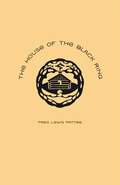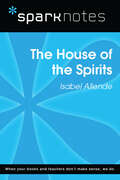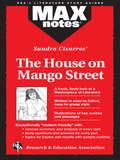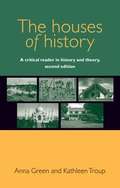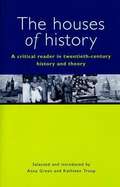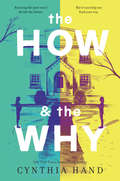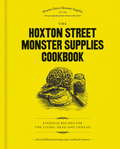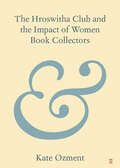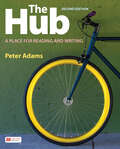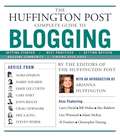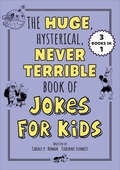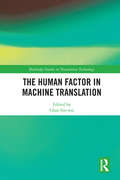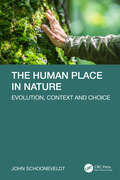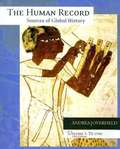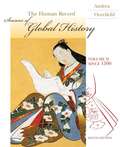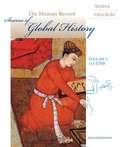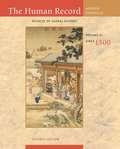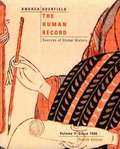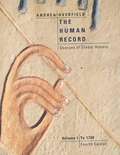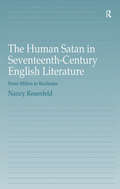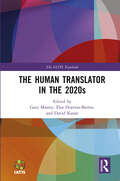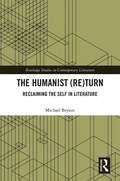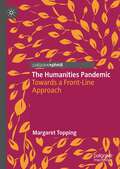- Table View
- List View
The House of the Black Ring: A Romance of the Seven Mountains
by Fred Lewis PatteeFred Lewis Pattee, long regarded as the father of American literary study, also wrote fiction. Originally published in 1905 by Henry Holt, The House of the Black Ring was Pattee’s second novel—a local-color romance set in the mountains of Central Pennsylvania. The book’s plot is driven by family feud, forbidden love, and a touch of the supernatural. This new edition makes this novel accessible to new generations of modern-day readers. General readers will find in The House of the Black Ring a thriller that preserves details of rural life and language during the late nineteenth century. Scholars will read it as an expression of cultural anxiety and change in the decades after the Civil War. An introduction by poet and essayist Julia Spicher Kasdorf situates the novel within the context of social and literary history, as well as Pattee’s own biography, and provides a compelling argument for its importance, not only as a literary artifact or record of local customs, but also as a reflection of Pattee’s own story intertwined with the history of Penn State at the turn of the twentieth century. Joshua Brown draws on his expertise in Pennsylvania German ethno-linguistics to interpret the dialect writing and to give readers a clearer view of the customs and regionalisms depicted in the book.
The House of the Spirits (SparkNotes Literature Guide Series)
by SparkNotesThe House of the Spirits (SparkNotes Literature Guide) by Isabel Allende Making the reading experience fun! Created by Harvard students for students everywhere, SparkNotes is a new breed of study guide: smarter, better, faster.Geared to what today's students need to know, SparkNotes provides:chapter-by-chapter analysis explanations of key themes, motifs, and symbols a review quiz and essay topics Lively and accessible, these guides are perfect for late-night studying and writing papers.
The House on Mango Street (Maxnotes Literature Guides)
by Elizabeth CheslaREA's MAXnotes for Sandra Cisneros' The House on Mango Street MAXnotes offer a fresh look at masterpieces of literature, presented in a lively and interesting fashion. Written by literary experts who currently teach the subject, MAXnotes will enhance your understanding and enjoyment of the work. MAXnotes are designed to stimulate independent thought about the literary work by raising various issues and thought-provoking ideas and questions. MAXnotes cover the essentials of what one should know about each work, including an overall summary, character lists, an explanation and discussion of the plot, the work's historical context, illustrations to convey the mood of the work, and a biography of the author. Each chapter is individually summarized and analyzed, and has study questions and answers.
The Houses Of History: A Critical Reader In History And Theory, Second Edition
by Anna Green Kathleen TroupThe houses of history is a clear, jargon-free introduction to the major theoretical approaches employed by historians. This innovative critical reader provides accessible introductions to fourteen schools of thought, from the empiricist to the postcolonial, including chapters on Marxist history, Freud and psychohistory, the Annales, historical sociology, narrative, gender, public history and the history of the emotions. Each chapter begins with a succinct description of the ideas integral to a particular theory. The authors then explore the insights and controversies arising from the application of this model, drawing upon debates and examples from around the world. Each chapter concludes with a representative example from a historian writing within this conceptual framework. This newly revised edition of the highly successful textbook is the ideal basis for an introductory course in history and theory for students of history at all levels.
The Houses of History: A Critical Reader in Twentieth-century History and Theory
by Anna Green Kathleen TroupEvery piece of historical writing has a theoretical basis on which evidence is selected, filtered, and understood. This is as true of scientific empiricism as it is of poststructuralism. The Houses of History provides a comprehensive introduction to the twelve schools of thought which have had the greatest influence on the study of history in the twentieth century. Ranging from Empiricism to Postcolonialism, Marxism to the Ethnohistorians, each chapter begins with an introduction to the particular school, the main protagonists, the critics, and is followed by a useful section of further readings. From the classic, such as G.R. Elton's "England Under the Tudors" and E.P. Thompson's "The Making of the English Working Class," to the recent, such as Henrietta Whiteman's "White Buffalo Woman" and Judith Walkowitz's "City of Dreadful Delight," the diverse selections collected here bring together the leading historians and theorists of the century. Comprehensive and accessible to undergraduates,The Houses of History is ideally suited to classroom use.
The How & the Why
by Cynthia HandCassandra McMurtrey has the best parents a girl could ask for; they’ve given Cass a life she wouldn’t trade for the world. She has everything she needs—but she has questions, too. Like, to know who she is. Where she came from. Questions her adoptive parents can’t answer, no matter how much they love her. But eighteen years ago, someone wrote Cass a series of letters. And they may just hold the answers Cass has been searching for.Alternating between Cass’s search for answers and letters from the pregnant teen who placed her for adoption, this emotionally resonant narrative is the perfect read for fans of Nina LaCour and Jandy Nelson.
The Hoxton Street Monster Supplies Cookbook: Everyday recipes for the living, dead and undead
by Hoxton Street Monster Supplies LimitedFor hundreds of years, the Hoxton Street Monster Supplies shop has been supplying quality goods for the monster community from its premises in east London - and this, its classic recipe book, has been in use for just as long.Now, for the first time, it has been adapted for use by humans as well as monsters. So whether you're entertaining trolls, hosting a vampire soirée or expecting zombies round for tea, you can make delicious treats to suit every occasion.- Fallen out with a friend? Bake them some 1000-year Curse Cookies!- Want to woo a zombie? Try our After-Gorging Breath Mints!- Unexpected ogre guests? Make our Fresh Maggot Brownies or Spiced Earwax Pie!With recipes and handy hints for monster housekeeping, this classic tome is an essential addition to every home, lair, cave, swamp or fiery pit.
The Hoxton Street Monster Supplies Cookbook: The Monster's Cookbook
by Hoxton Street Monster Supplies LimitedFor hundreds of years, the Hoxton Street Monster Supplies shop has been supplying quality goods for the monster community from its premises in east London - and this, its classic recipe book, has been in use for just as long.Now, for the first time, it has been adapted for use by humans as well as monsters. So whether you're entertaining trolls, hosting a vampire soirée or expecting zombies round for tea, you can make delicious treats to suit every occasion.- Fallen out with a friend? Bake them some 1000-year Curse Cookies!- Want to woo a zombie? Try our After-Gorging Breath Mints!- Unexpected ogre guests? Make our Fresh Maggot Brownies or Spiced Earwax Pie!With recipes and handy hints for monster housekeeping, this classic tome is an essential addition to every home, lair, cave, swamp or fiery pit.
The Hroswitha Club and the Impact of Women Book Collectors (Elements in Publishing and Book Culture)
by Kate OzmentThe Hroswitha Club was a group of women book collectors who met from 1944–2004 in the Eastern United States. Despite the fame of individual members like Henrietta Bartlett or Mary Hyde Eccles, there is no sustained study of the Club's work and legacy. This Element makes this history broadly accessible and focuses on how members shared knowledge and expertise and provided a space for legitimacy and self-growth in a period where women's access to formal education and academic institutions was limited. By making this network visible through an examination of archival records, library catalogs, and pamphlets, this project positions the Club as a case study for a more thorough examination of the ways that intersectional identities can make visible or obscure whose intellect, money, and resources have shaped the study of rare books in the United States.
The Hub: A Place for Reading and Writing
by Peter AdamsThe Hub offers reading/writing projects that will help you succeed in any college course, not just composition courses.
The Huffington Post Complete Guide to Blogging
by Arianna Huffington The editors of the Huffington PostThe editors of The Huffington Post -- the most linked-to blog on the web -- offer an A-Z guide to all things blog, with information for everyone from the tech-challenged newbie looking to get a handle on this new way of communicating to the experienced blogger looking to break through the clutter of the Internet. With an introduction by Arianna Huffington, the site's cofounder and editor in chief, this book is everything you want to know about blogging, but didn't know who to ask. As entertaining as it is informative, The Huffington Post Complete Guide to Blogging will show you what to do to get your blog started. You'll find tools to help you build your blog, strategies to create your community, tips on finding your voice, and entertaining anecdotes from HuffPost bloggers that will make you wonder what took you so long to blog in the first place. The Guide also includes choice selections from HuffPost's wide-ranging mix of top-notch bloggers. Among those who have blogged on HuffPost are Barack Obama, Hillary Clinton, Larry David, Jane Smiley, Bill Maher, Nora Ephron, Jon Robin Baitz, Steve Martin, Lawrence O'Donnell, Ari Emanuel, Mia Farrow, Al Franken, Gary Hart, Barbara Ehrenreich, Edward Kennedy, Harry Shearer, Nancy Pelosi, Adam McKay, John Ridley, and Alec Baldwin.
The Huge, Hysterical, Never Terrible Book of Jokes for Kids (Silly Jokes)
by Carole P. Roman Corinne SchmittGet silly as you practice problem-solving with 2,000 riddles and jokes for kids of all ages!Are you ready for hours of entertainment, guaranteed to make you laugh and tease your brain? Then you've come to the right place, because this book of jokes is a giant combination of THREE popular joke books for kids. Inside, you'll discover tons of silly fun that will engage your imagination, cultivate your creative thinking skills, and have you howling with hysterics!This huge 3-in-1 collection includes:The Big Book of Silly Jokes for Kids: This beloved bestseller is packed with knee-slapping knock-knocks, side-splitting puns, and more!The Big Book of Silly Jokes for Kids 2: Keep the fun going with even more clean and corny jokes for the whole family.Tricky Riddles for Kids: Put your brain to the test with a collection of silly riddles that get more challenging as you go. How many can you solve? Sharpen your skills and have a blast with The Huge, Hysterical, Never Terrible Book of Jokes for Kids!
The Human Factor in Machine Translation (Routledge Studies in Translation Technology)
by Sin-Wai ChanMachine translation has become increasingly popular, especially with the introduction of neural machine translation in major online translation systems. However, despite the rapid advances in machine translation, the role of a human translator remains crucial. As illustrated by the chapters in this book, man-machine interaction is essential in machine translation, localisation, terminology management, and crowdsourcing translation. In fact, the importance of a human translator before, during, and after machine processing, cannot be overemphasised as human intervention is the best way to ensure the translation quality of machine translation. This volume explores the role of a human translator in machine translation from various perspectives, affording a comprehensive look at this topical research area. This book is essential reading for anyone involved in translation studies, machine translation or interested in translation technology.
The Human Place in Nature: Evolution, Context and Choice
by John SchooneveldtThis book explores a new approach to understanding the evolution of mind and consciousness by examining the perceptual abilities of animals and the way they experience their world. It offers a science-based bottom-up approach to our own conscious worldview by seeing it through the eyes of others. Emphasis is on the role of context in evolution and the way animals internalize and engage with the contextual properties of their world that are meaningful for them. The core argument is that a context, which is subjective and comprised of the perceptual capacities, offers new insights into the evolution of mind. Rather than seeing biological evolution in terms of the emergence of mindless forms and cultural evolution as the emergence of disembodied minds, the book seeks to integrate these two perspectives through the rigorous mapping of contexts.Key Features Reveals an understanding of animal minds Formulates a hypothesis for the evolution of consciousness Includes a discussion of the origin of technological innovation Provides a rationale for the ecology of mind Proposes a theory of the evolution of language Outlines the science of experience and how it influences choice Explains the role of context and choice with respect especially to human ecology
The Human Record To 1700: Sources Of Global History
by Alfred J. Andrea James H. OverfieldThe Human Record is a leading collection of primary sources for world history courses and can be used as either a core or supplementary text. Unlike many world history texts that center on the West, The Human Record provides balanced coverage of the global past. The book features both written and artifactual sources placed in their full historical contexts through introductory essays, footnotes, and focus questions. Each volume in the Fifth Edition begins with a prologue-"Primary Sources and How We Read Them"-that introduces students to the proper methods for reading and interpreting primary source material; the authors also walk students through sample visual and textual sources to help them master this skill. Part, chapter, section, and individual source introductions help students place primary sources within a historical context. New! Approximately one-third of the selections in each volume are new to this edition, and many of the remaining sources contain updated explanations and focus questions. New! The final chapter in Volume II has been revised to include coverage of recent global events such as the September 11th attacks. "Questions for Analysis," which precede each source, are presented in a three-tiered format that resembles a historian s approach to source analysis. Each volume contains a Table of Contents organized by topical and geographical criteria. Several visual sources, such as photos of coins, sculptures, paintings, and textiles, are provided in each volume.
The Human Record: Since 1500
by Alfred J. Andrea James H. OverfieldNow in its Sixth Edition, The Human Record continues to be the leading primary source reader for the World History course. Each volume contains a blend of visual and textual sources; these sources are often paired or grouped together for comparison. A prologue entitled, "Primary Sources and How to Read Them," appears in each volume and serves as a valuable pedagogical tool. Unlike many world history texts that center on the West, The Human Record provides balanced coverage of the global past. Approximately one-third of the sources in the Sixth Edition are new, and these documents continue to reflect the myriad experiences of the peoples of the world.
The Human Record: Sources Of Global History To 1700
by Alfred J. Andrea James H. OverfieldNIMAC-sourced textbook
The Human Record: Sources of Global History - Since 1500 (Seventh Edition)
by Alfred J. Andrea James H. OverfieldTHE HUMAN RECORD is the leading primary source reader for the World History course, providing balanced coverage of the global past. Each volume contains a blend of visual and textual sources which are often paired or grouped together for comparison. A prologue entitled "Primary Sources and How to Read Them" appears in each volume and provides background and guidance for analyzing sources such as those in the text. Approximately one-third of the sources in the Seventh Edition are new, and these documents continue to reflect the myriad experiences of the peoples of the world.
The Human Record: Sources of Global History Volume II, Since 1500
by Alfred J. Andrea James H. OverfieldUnlike some other world history texts that center on the West, The Human Record provides balanced coverage of the global past. The book features both written and artifactual sources that are placed in their full historical contexts through introductory essays, footnotes, and focus questions. The text sheds light on the experiences of women and non-elite groups while maintaining overall balance and a focus on the major patterns of global historical developments through the ages.
The Human Record: To 1700 (4th edition)
by Alfred J. Andrea James H. OverfieldUnlike some other world history texts that center on the West, The Human Record provides balanced coverage of the global past. The book features both written and artifactual sources that are placed in their full historical contexts through introductory essays, footnotes, and focus questions. The text sheds light on the experiences of women and non-elite groups while maintaining overall balance and a focus on the major patterns of global historical developments through the ages.
The Human Satan in Seventeenth-Century English Literature: From Milton to Rochester
by Nancy RosenfeldFramed by an understanding that the very concept of what defines the human is often influenced by Renaissance and early modern texts, this book establishes the beginning of the literary development of the satanic form into a humanized form in the seventeenth century. This development is centered on characters and poetry of four seventeenth-century writers: the Satan character in John Milton's Paradise Lost and Paradise Regained, the Tempter in John Bunyan's Grace Abounding to the Chief of Sinners and Diabolus in Bunyan's The Holy War, the poetry of John Wilmot, earl of Rochester, and Dorimant in George Etherege's Man of Mode. The initial understanding of this development is through a sequential reading of Milton and Bunyan which examines the Satan character as an archetype-in-the-making, building upon each to work so that the character metamorphoses from a groveling serpent and fallen archangel to a humanized form embodying the human impulses necessary to commit evil. Rosenfeld then argues that this development continues in Restoration literature, showing that both Rochester and Etherege build upon their literary predecessors to develop the satanic figure towards greater humanity. Ultimately she demonstrates that these writers, taken collectively, have imbued Satan with the characteristics that define the human. This book includes as an epilogue a discussion of Samson in Milton's Samson Agonistes as a later seventeenth-century avatar of the humanized satanic form, providing an example for understanding a stock literary character in the light of early modern texts.
The Human Translator in the 2020s (The IATIS Yearbook)
by Gary Massey David Katan Elsa Huertas-BarrosHas the language industry of the 21st century been racing ahead of the translation profession and leaving translators behind? Or are translators adapting to new sociotechnical realities and societal demands, and if so, how? The chapters in this volume seek to shed light on the profiles and position of human translators in the current decade. This collection draws together the work of leading authors to reflect on the constantly evolving language industry. The eight chapters present new perspectives on, and concepts of, translation in a digital world. They highlight the shifts taking place in the sociotechnical environment of translation and the need to address changing buyer needs and market demands with new services, profiles and training. In doing so, they share a common focus on the added value that human translators can and do bring to bear as adaptive, creative, digitally literate experts. Addressing an international readership, this volume is of interest to advanced students and researchers in translation and interpreting studies, and professionals in the global language industry.
The Humanist (Routledge Studies in Contemporary Literature)
by Michael BrysonThe exciting new book argues for a renewed emphasis on humanism--contrary to the trend of post-humanism, or what Neema Parvini calls "the anti-humanism" of the last several decades of literary and theoretical scholarship. In this trail-blazing study, Michael Bryson argues for this renewal of perspective by covering literature written in different languages, times, and places, calling for a return to a humanism, which focuses on literary characters and their psychological and existential struggles—not struggles of competition, but of connection, the struggles of fragmented, incomplete individuals for integration, wholeness, and unity.
The Humanities "crisis" And The Future Of Literary Studies
by Paul JayDemonstrating that the supposed drawbacks of the humanities are in fact their source of practical value, Jay explores current debates about the role of the humanities in higher education, puts them in historical context, and offers humanists and their supporters concrete ways to explain the practical value of a contemporary humanities education.
The Humanities Pandemic: Towards a Front-Line Approach
by Margaret ToppingThis book explores how the Humanities can play an essential services role in addressing global challenges such as the Covid pandemic. In arguing for their contribution alongside that of the Health Sciences, it calls for a new critical engagement – honest and self-reflective – from Humanities scholars with the question of how to overcome a fundamental challenge facing universities globally: finding a common language and set of ‘cultural’ assumptions between disciplines as the basis for communication. The book looks at the nature of the challenges that can beset collaboration across disciplines (and indeed across sectors, notably between researchers and the general public) and argues for a new Translational Humanities, in both the sense of an applied Humanities and a Humanities that can translate itself across disciplines and sectors. Crucially, too, it suggests that it is not narratives such as a pandemic novel or contagion film that successfully engage with contentious debates about the challenges of Covid, but rather critically distant texts and thematic contexts that typically place the self in the position of other like travel narratives. This book sits at a previously unconsidered intersection between debates around interdisciplinary collaboration and communication, theories of intercultural contact and encounter, and the role of the Humanities in tackling global issues.
